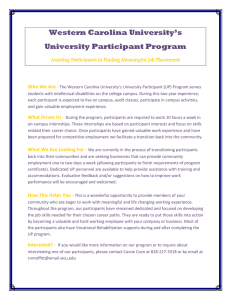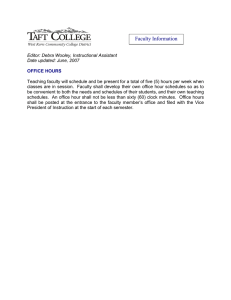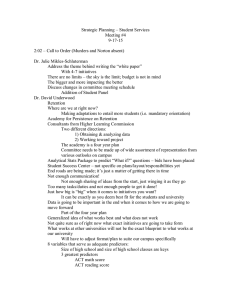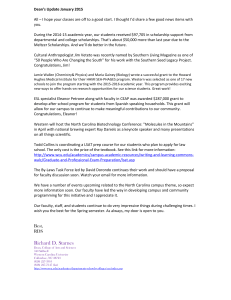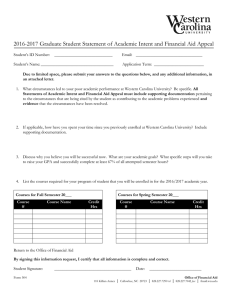Pragmatic Evaluation: Student Schedules Seb Prohn University Participant Program
advertisement
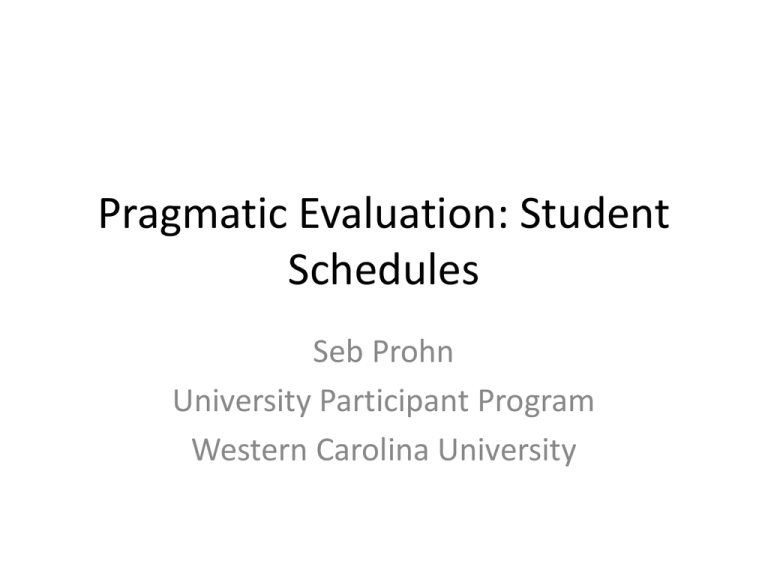
Pragmatic Evaluation: Student Schedules Seb Prohn University Participant Program Western Carolina University Presentation ‘Schedule’ # of Slides Description 1 Evaluation subsection 2 UP evaluations 1 Why activity schedules? 7ish Using schedules for evaluation 1 Questions Measurement & Analysis • Let’s acknowledge the evaluation process • If you want a quick ‘brush up’ betterevaluation.org UP Evaluations • Paid supports & academic supports • Campus climate – attitudes & social inclusion • Program – – – – Participatory evaluation SWOT analysis Carolina Institute for Developmental Disabilities, UNC TPSID • Students Student Evaluations • • • • • • • Work evaluation cards: Work support Instructor surveys Internet surveys: behavior; individualized goals PCP meeting notes Parent surveys: Support Intensity Scale Student questionnaires: Self-determination Student schedules: Weekly hours supported; hrs in 5 content areas Weekly Activity Schedules • Strengths – Practical tool for students, program & others – Hours as a unit of measure – The Method is an intervention – Positive research • Limitations – Quantity vs Quality – Time consuming Staff/Support View Whentowork.com Student View Tracking Requirement Hours • 1800 learning hrs. across 4 semesters • Each semester need 90 hrs. per program area Partitioning activities Personal Development Social Participation Vocational Preparation Community Participation Academic Participation Cooking Shared meals Work Volunteering Class Social skills Clubs & organizations Vocational skills training Campus navigation Homework/ studying Cleaning/ laundry Concerts & Job fairs sporting events Off campus recreation Exams/projects /assessments Advising meetings Hanging out with friends Employee meetings Rec therapy Note: This is a sample list and is not exhaustive. Dependent Variable: Support Needs* • Use scheduling software & schedules • Examine ‘hours supported’ while doing program related activities • Self-evaluation: The Face Test – “I’m more independent. On my schedule there are more pictures of me on there.” 2nd Year UP Participant *We colloquially refer to this as ‘independence’ Support hours per day (7 students) Support needs for UP students (7) in the 2012-13 academic year 85 80 75 70 65 60 55 50 45 40 35 30 25 20 15 10 5 0 1 2 3 4 5 6 7 8 9 10 11 12 13 14 15 16 17 18 19 20 21 22 23 24 25 26 27 28 29 30 Weeks in 2012-13 Academic Year Comparing Quarters • F( 3, 220)= 19.11, p < .01, r2 = .46 2012-2013 school year Mean Daily Hrs. of Support per student Fall 1 (Q1) 10.58 Fall 2 (Q2) 7.63 Spring 1 (Q3) 9.08 Spring 2 (Q4) 7.22 “when we start working independently then our supports start to fade. Eventually you get to work on your own and learn your way around campus. And then we will be able to help the new students and that kind of thing.” 1st year UP Participant Other uses • Compare changes within and between students – Intervention – Increasingly specialized support • Where is support constant? Why? Questions Seb Prohn University Participant Program Western Carolina University up.wcu.edu smprohn@email.wcu.edu
